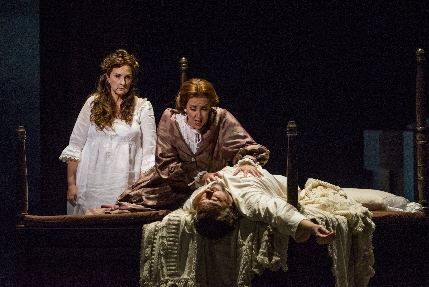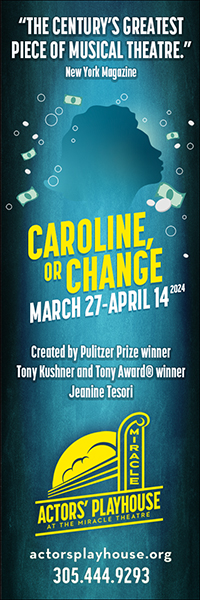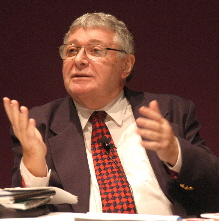
Daughter Lavinia is a bit perturbed that mother Christine has murdered her father in Florida Grand Opera’s production of Mourning Becomes Electra / Photo by Justin Namon.
By Bill Hirschman
Considering that some aficionados say Mourning Becomes Electra is one of the most thrilling operas ever written, Fort Lauderdale composer Marvin David Levy can be forgiven a bit of curmudgeonly pique that it’s also one you’ve never heard.
It premiered in the Metropolitan Opera’s inaugural residency at Lincoln Center in 1967. But it only survived one more season, played twice overseas, then disappeared for 30 years. It was resurrected in a triumphant revision in Chicago in 1998, then in a rapturously received co-production in Seattle and New York City in 2004. And then it disappeared again.
Only now, nearly a decade later, is Levy’s masterwork being heard in his adopted city. On Thursday, it will open Florida Grand Opera’s 73rd season at the Broward Center for the Performing Arts, a renaissance stirring international news coverage and visits from administrators from other opera companies showing interest in a further life.
The 81-year-old Levy is obviously gratified, but his droll sense of humor can’t hide resentment at the late arrival and the attendant attention.
“I don’t know why they are coming,” he said testily at his kitchen table in his modest Riverland home last week. “There were so many people there at the dress rehearsal for the New York City Opera (production) that they should have been there if they had any interest in it. And now all of a sudden they’re coming here.”
Its three-decade vanishing act left a lasting wound. “I never wrote another big opera after Mourning Becomes Electra. And why? Because I was pissed. I immediately knew what it was,” meaning that he knew its worth. “I’m not saying it was the greatest opera in the world but it wasn’t a bad opera and it was at least as good as some of the junk I’ve heard.”
Its absence has been the public’s loss, according to Justin Moss, FGO’s director of Broward operations, a legendary font of opera lore and acquaintance of Levy’s since 1993.
Moss said of the 1998 revival at the Lyric Opera of Chicago, “I have to tell you, and I’m not exaggerating by any means, it was one of the most thrilling, exciting evenings I have ever spent in an opera house. And the rest of the people (in the audience) had the same reaction.”
Remembered for raging passions incarnated in the score, the opera is based on Eugene O’Neill’s 1931 trilogy of plays stretching across more than five hours and 13 acts. O’Neill transported Aeschylus’ Greek tragedy Oresteia about Agamemnon, Clytemnestra and Electra and set it in the post-Civil War era. All three tales are marked by a devastating range of familial dysfunction encompassing incest, murder and revenge among the adulterous matriarch Christine Mannon, her husband Ezra, her lover Adam Brant, her daughter Lavinia and her son Orin.
The work was chosen by FGO’s new CEO and general director Susan Danis for the first season under her own aegis to send a clear message that FGO was evolving.
Moss said Danis “made a really, really courageous gesture by deciding, ‘I want to open my season with a great American masterpiece that very few people have ever seen.’ And although it will be tough to educate the public to see something new, there’s a huge value to doing that rather than seeing your 10th or 12th production of La Boheme.”
This production, atypically built from scratch for Florida Grand Opera under the direction of Kevin Newbury, stars soprano Lauren Flanigan as Christine, a role she has played in all three productions of the last 15 years. She is joined by soprano Rayanne Dupuis who played Lavinia alongside Flanigan in Seattle. Baritone Morgan Smith, who played a different part in Seattle, now takes the key role of Adam. Newbury, who wrote that he has always been interested in the supernatural, has incorporated scrims and moving screens to accommodate atmospheric projections; the scenery includes a mysterious dollhouse that echoes the Mannon homestead.
Levy chose the work in the first place because he felt the play desperately needed to be streamlined. “The reason it cries out to be an opera is also the reason it wasn’t a very good play. (The play) is much, much too long, the prose is as purple as you can imagine and poor O’Neill knew that. He actually wrote in a letter, and I have the letter somewhere, that he didn’t have one element that he needed to write Mourning Becomes Electra, and that was poetic eloquence.”
A HISTORY LESSON
The history of the opera is as tortured as the meat of the piece itself. In his late 20s, Levy became intrigued by O’Neill’s masterwork. With the blessing of O’Neill’s widow, Carlotta, Levy began to work on it with librettist Henry Butler in 1961.
When the Metropolitan Opera moved into the new Lincoln Center in New York City in 1966, the Ford Foundation commissioned two new works. One was Mourning Becomes Electra, primarily, Levy now guesses, “because it had a famous name and the famous name wasn’t mine.”
Levy dove back in to the long-gestating piece and heavily reworked it. He produced a lush, massive piece employing a 90-piece orchestra. It was, by all accounts, epic in its sound and scope but notable for the atonal palette that was the rage at the time.
Moss said, “Dissonant and angular and atonal music was sort of demanded. Academic musicology, everyone across the country, every music department, every conservatory was subscribing to the theory that… if people didn’t suffer, something was wrong.”
Critics were deeply divided over the merits of the finished score conducted by Zubin Mehta, but they admired the libretto that condensed O’Neill’s sprawling plot into one opus. The irony was the director – the multi-disciplinary auteur Michael Cacoyannis of Zorba The Greek fame – had heavily rewritten the book, Levy said.
Mourning Becomes Electra was performed the following season at the Met, then once in Germany, once in Zurich and then vanished. The exile quietly devastated Levy. He wrote other pieces, but he never touched the opera. Other than people’s memories, the only easily available vestige of it was a bootleg recording from the radio broadcast of the Met production and a recent You Tube video of one aria.
The banishment may have resulted from the reticence of companies facing financial woes to try works that their audiences had never heard of, Moss surmised. “It’s never going to sell as many tickets as La Boheme or The Magic Flute or Rigoletto,” he said.
Levy continued teaching and writing. He began living part-time in Fort Lauderdale in 1987 where he worked on a commission for the 1988 Chicago Symphony season, an oratorio about the Masada siege and suicides in Jewish history. With local contacts, he earned a commission from the Philharmonic Orchestra of Florida to write another oratorio, Pascua Florida, which funneled a Gregorian chant through a Latin sensibility. His resume also grew to include a piano concerto written for Earl Wild, who premiered it with the Chicago Symphony Orchestra conducted by George Solti; Kyros, a dance-poem for chamber orchestra; Trialogus, also performed by the Chicago Symphony, and a Passover opera commissioned for an ABC network television broadcast by the Jewish Theological Seminary.
In 1990, he became the artistic director when the Opera Guild of Fort Lauderdale became the Fort Lauderdale Opera. But soon after the group hired Justin Moss to be managing director in 1993, it merged with the Greater Miami Opera to become the Florida Grand Opera.
But Electra never quite died. Word of mouth kept it on several opera companies’ to-do list for years and years.
The logjam broke around 1996. One of his admirers, general director of the Lyric Opera of Chicago Ardis Krainik, was brainstorming with Zubin Mehta and advisor Matthew Epstein about a ten-year plan for the company. The men suggested the work Mehta had conducted decades earlier. As Levy tells it, she agreed, “I’ll look into that, (although) why she didn’t look into it earlier, I don’t know.” Levy’s reaction? “I said, ‘Well it’s about time.’ These things happen so stupidly.”
He didn’t feel validated, only grateful for the opportunity to overhaul the piece in the more lyrical style he preferred. The process entailed months of round-the-clock work over two years. He reduced the number of instruments, re-orchestrated it, slimmed it down, rewrote the libretto once again and curtailed the once trendy atonality to reflect his love of bel canto music with its soaring melody for singers.
Today, he plays down how much he softened the atonality, although most observers are universally agreed on that point. He shrugs at that perception. “It depends on someone’s ears. I can’t hear it the way other people hear it. It’s just not possible.”
Moss described it this way: “He went through the score over the years thinking, ‘There’s an easier way to do this. Why did I feel so compelled to make a big dissonant chord? I have a choice, I feel less constrained.’
Levy’s recollection is “I changed it harmonically and most every other way. It felt like it was too bouncing around.” He even included two electric synthesizers “for coloration.”
It all paid off. The 1998 Chicago production was an unqualified success with sold-out crowds from word of mouth and Levy getting uniformly solid notices three decades late. Among the observers was Speight Jenkins, the artistic director for the Seattle Opera who has disliked the Met production but was now enthralled by the revision.
A few years later, he got the call from Jenkins to make even more changes for a co-production of the Seattle Opera, which had recently renovated its new Marion Oliver McCaw Hall, and the New York City Opera. The productions directed by up-and-comer Bartlett Sher enjoyed similar rave reviews and audience response.
For those editions, Levy said, he changed the structure from three acts to two acts and “rewrote the whole ending to get more characters on stage.”
“It didn’t end satisfactorily for me. But I have to beg off, it’s not really all my fault because the play doesn’t end properly. It has two powerful women on stage for two acts and in Act Three…one of them is dead and the other might as well be dead. So I brought the other back as a ghost. That was interesting because I went back to the original Aeschylus trilogy.” In his third play, The Furies, “lo and behold, there is Christine as a ghost. If it’s good enough for Aeschylus, it’s good enough for me.”
While he hasn’t made any major changes for the current version, he has been tweaking it. “Errors always pop up, what they’re performing. Sometimes it’s what’s written or sometimes they don’t read it properly. All sorts of little things.” He’s sat in on some rehearsals because “I want to be sure the singers are comfortable. Every singer is different. Not only are they different but they change constantly. They get older.” For instance, 15 years on, Flanigan’s voice “has matured,” he said.
Levy knows the vagaries of opera production from the inside. A graduate of Juilliard Preparatory, New York University and Columbia University, Levy wrote his first one-act opera, The Tower, when he was 24 years old, a comic biblically based fable for the Santa Fe Opera. Two other one-acts followed: Sobota Komachi, based on a 14th-century Japanese Noh play; and Escorial, based on a play by Michel de Ghelderode. The latter launched the career of American baritone Sherrill Milnes – who would later appear in the premiere of Mourning Becomes Electra.
But he learned an incalculable amount even before leaving school by working as an archivist and later assistant director of the American Opera Society, which hosted concert and semi-staged versions of bel canto operas in New York City. It provided a way for him to begin creating relationships with many of the major figures of what he calls the golden age of opera, including Maria Callas.
“Callas was really gripping…. She was not the brightest star in the heavens. It didn’t matter because she had the instinct of the brightest star in the heavens and it was all instinct with her…. She knew what was right. Her bones told her do this and don’t do that. People like that, you hear in a performance and your mouth hangs open. Where did she come up with that? In Tosca, she came up with sounds that were absolutely brand new.”
LIFE AFTER RESURRECTION
Levy is looking past this production, but ill health has curtailed some of his activities. Since the Chicago production, he has reportedly looked into tackling a wide range of pieces, but none are active. He has been working for years on a children’s musical comedy The Zachary Star which had a local reading a few years ago.
For now, he is focused on people finally seeing his masterwork that, at best, they have only heard about. He’s actually glad they have few preconceptions.
“I want them to come in with a flat tabula rasa and see how it grabs them from that standpoint. Some people will think it’s a lot of noise. Some people will find it lyrical. It depends on their ears. You can’t tell what somebody hears. You just don’t know.”
“All I can do is write what I like.”
Mourning Becomes Electra from the Florida Grand Opera plays at the Broward Center for the Performing Arts, Au-Rene Theater, 201 SW Fifth Ave., Fort Lauderdale at 7:30 p.m. Thursday and Saturday. Then it moves to Adrienne Arsht Center for the Performing Arts, 1300 Biscayne Blvd., Miami at 7 p.m. Saturday Nov. 16, 2 p.m. Sunday Nov. 16, 8 p.m. Nov. 19 and 23. Tickets start at $11 in Broward and $21 in Miami and top out at $200. Call (800) 741-1010 or visit www.FGO.org.









 A PaperStreet Web Design
A PaperStreet Web Design
